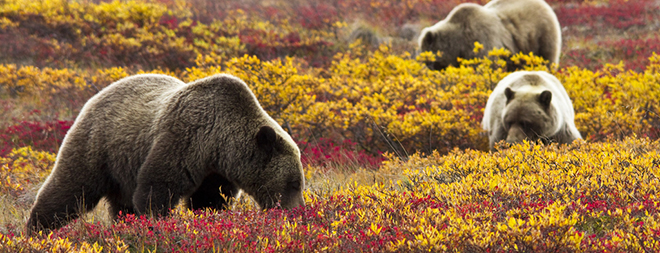Grizzly Bears' Diet Improves With Gray Wolf Re-appearance

(Inside Science) -- Efforts to reintroduce wolves to Yellowstone National Park have curbed a teeming elk population, but have also had an unexpected benefactor: the grizzly bear.
In the early 1900s, gray wolves and grizzly bears were abundant in the park, as were a variety of berry-producing shrubs.
During summer, the grizzly bears stocked up on the fat from the berries for energy needed during hibernation. Unfortunately, elk also grazed on the shrubs the berries grow on, competing directly with the grizzly bears.
Gray wolves, for their part, preyed on the elk, keeping their numbers in check, and indirectly helping the grizzly bears get more fruit in their diet. Grizzlies aren't fast enough to hunt mature elk.
But after hunters nabbed the last Yellowstone gray wolf in the 1920s and park biologists ended elk-culling efforts, elk numbers started rising, growing by six times in 26 years, Oregon and Washington State University ecologists report in the Journal of Animal Ecology.
More elk meant fewer berries for the bears, which started scrambling for alternate sources of food, including garbage in the park. After open garbage was also banned in 1971, the number of grizzly bears started decreasing. In 1975, they were labeled as a “threatened species” by the US government, the paper reported.
The elk boom also brought down the number of woody trees such as willow, aspen and cottonwood, the researchers found. These trees are also important to the grizzly bear: their dense canopy provides a hiding place for the bear to rest and eat.
In the mid-1990s, gray wolves were brought down from Alberta, Canada to Yellowstone, as part of the Northern Rocky Mountain Wolf Recovery Plan, by the US government.
Since the wolves’ return, elk populations have dropped by ten percent and the grizzly bears have started eating more berries, indicated by the almost doubling of the fruit content in the bears’ droppings in August -- when they need the berries most -- the researchers reported.
Earlier studies have linked elk populations to the grizzly bear’s diet, but few have drawn the connection from wolf to bear, noted William Ripple, an ecologist at Oregon State University in Corvallis, and lead author of the study.
The grizzly bears were also found to “capitalize” on the wolves' return by scavenging on the elk carcasses the wolves left behind, he said, referring to an earlier study.
However, it remains to be seen if the recent drop in elk population will affect the bear’s dependence on their carcasses, he acknowledged.
“Science is still fairly ignorant about the complexities of nature and how changes in one species might affect other species in the ecosystem,” he said. “It is important that we understand how these top predators function, and their effects on the food web.”
As the Yellowstone grizzly bear’s other food sources such as whitebark pine nuts and cutthroat trout also dwindle with climate change, their dependence on berries may grow, Ripple said.
Ranjini Raghunath is a science writer in Mountain View, California
